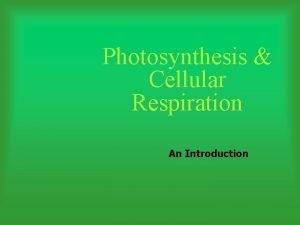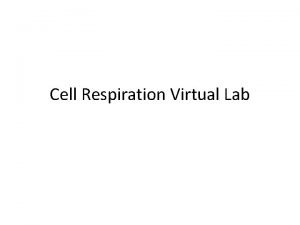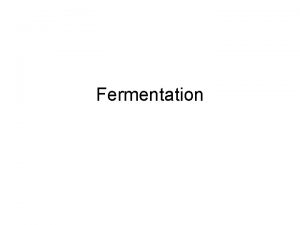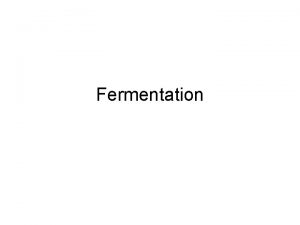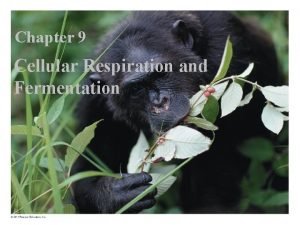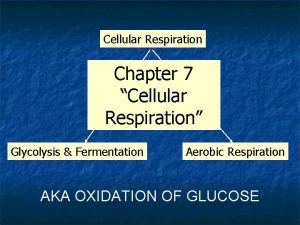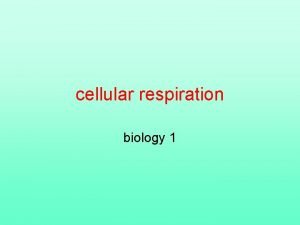Chapter 9 Cellular Respiration and Fermentation I Cellular















- Slides: 15

Chapter 9 : Cellular Respiration and Fermentation I. Cellular Respiration : An Overview A. Chemical Energy and Food *Organisms get the energy they need from food. -Energy stored in food is expressed in units of calories. -Most foods contain thousands of calories.

Types of Calories -There are two different types of calories : 1. calories – a measure of how much energy is in food. It is the amount of energy needed to raise 1 gram of water 1 degree Celsius. Example : A candy bar has about 200, 000 calories.

Calories 2. Calories – are actually kilocalories or the equivalent of 1, 000 calories each. **These are the Calories found on our food labels. ** Example : A candy bar has about 200 Calories.

Applying Concepts Problem : If a serving of popcorn on a food label has 140 Calories, how many calories does it actually have? Answer : 140 C x 1, 000 = 140, 000 calories

Using Food Molecules -Cells break down food molecules gradually, capturing a little bit of chemical energy at key steps. -This enables them to use the energy stored in the chemical bonds of foods like glucose to produce ATP for powering cellular activities.

B. Overview of Cellular Respiration *Recall : Cellular Respiration - the process that releases energy from food in the presence of oxygen (aerobic). 6 O 2 + C 6 H 12 O 6 6 CO 2 + 6 H 2 O + Energy Oxygen + Glucose Carbon dioxide + Water + Energy (Reactants) (Products) -Cellular respiration occurs in steps/stages so that it slowly releases the energy stored in food. If that energy were released too suddenly, most of it would be lost in the forms of light and heat.

II. The Process of Cellular Respiration A. 3 Stages of Cellular Respiration 1. Glycolysis – during this stage 1 molecule of glucose (a 6 -carbon compound) is transformed into 2 molecules of pyruvic acid (a 3 -carbon compound). As bonds break and rearrange energy is released. ATP and NADH are produced. -This stage is anaerobic (doesn’t require oxygen to happen), occurs in the cytoplasm of cells, and yields a net gain of 2 ATP when finished.

Glycolysis and the production of ATP and NADH ATP Production a. To start the process of glycolysis, cells must use 2 ATP molecules. b. Overall, glycolysis produces 4 ATP molecules. c. This gives a net gain of 2 ATP molecules. NADH Production a. Four high-energy electrons are passed to the carrier NAD+ to produce NADH. b. NADH carries these electrons to the electron transport chain.

Stage #2 : The Krebs Cycle 2. Krebs cycle – during this stage, pyruvic acid is broken down into carbon dioxide in a series of energy-extracting reactions. -Discovered by Hans Krebs (British biochemist), it is sometimes called the citric acid cycle because citric acid is the first compound formed in this series of reactions.

Stage #2 : The Krebs Cycle -This stage is aerobic (requires oxygen to happen), occurs in the matrix (innermost compartment) of the mitochondrion, and yields a net gain of 2 ATP when finished. -As this stage progresses, pyruvic acid from glycolysis is used to make carbon dioxide, NADH, ATP, and FADH 2.

Stage #2 : The Krebs Cycle • Carbon dioxide made here is expelled when we exhale. • The ATP molecules made here become immediately available to power cellular activities. • The electrons held in carrier molecules (ex : NADH & FADH 2), in the presence of oxygen, are used to generate huge amounts of ATP when passed to the last stage.

Stage # 3 : Electron Transport Chain 3. Electron transport chain – during this stage, the high-energy electrons from glycolysis and the Krebs cycle (NADH & FADH 2) are used to convert ADP into ATP. -This stage is aerobic, occurs in the inner membrane of the mitochondrion, and yields a net gain of 32 ATP when finished.

Stage # 3 : Electron Transport Chain Electron transport a. High energy electrons from NADH and FADH 2 are passed from carrier to carrier, down the electron transport chain. b. Water is formed when oxygen accepts the electrons in combination with hydrogen ions. c. Energy generated by the electron transport chain is used to move H+ ions across the inner mitochondrial membrane and into the intermembrane space.

Stage # 3 : Electron Transport Chain ATP Production *Cells use chemiosmosis - the movement - of ions across a selectively permeable membrane, down their electrochemical gradient, to generate ATP. a. Enzymes (ATP synthases) in the inner mitochondrial membrane channel H+ ions and convert ADP into ATP. b. Each pair of high-energy electrons that moves down the electron transport chain provides enough energy to make about 3 molecules of ATP, totaling about 32 ATP from this stage. *By the end of all 3 stages of cellular respiration, the process generates about 36 ATP. *

B. Connecting Cellular Respiration and Photosynthesis *Cellular respiration and photosynthesis can be thought of as opposite reactions. -Photosynthesis removes carbon dioxide from the atmosphere, and cellular respiration puts it back. Photosynthesis releases oxygen into the atmosphere, and cellular respiration use that oxygen to release energy from food.
 La respiration et la fermentation
La respiration et la fermentation Chapter 8 section 3 cellular respiration continued
Chapter 8 section 3 cellular respiration continued Cellular respiration harvesting chemical energy
Cellular respiration harvesting chemical energy Chapter 9 cellular respiration harvesting chemical energy
Chapter 9 cellular respiration harvesting chemical energy Chapter 9: cellular respiration: harvesting chemical energy
Chapter 9: cellular respiration: harvesting chemical energy Complimentary processes
Complimentary processes Are photosynthesis and cellular respiration opposites
Are photosynthesis and cellular respiration opposites Formula for celluar respiration
Formula for celluar respiration Function of cellular respiration
Function of cellular respiration Where does cellular respiration take place
Where does cellular respiration take place Cellular respiration foldable ap biology
Cellular respiration foldable ap biology Edpuzzle cellular respiration
Edpuzzle cellular respiration Photosynthesis and cellular respiration
Photosynthesis and cellular respiration Cellular respiration virtual lab snails and elodea
Cellular respiration virtual lab snails and elodea The mimosa plant displays thigmotropism
The mimosa plant displays thigmotropism Photosynthesis and cellular respiration jeopardy
Photosynthesis and cellular respiration jeopardy












